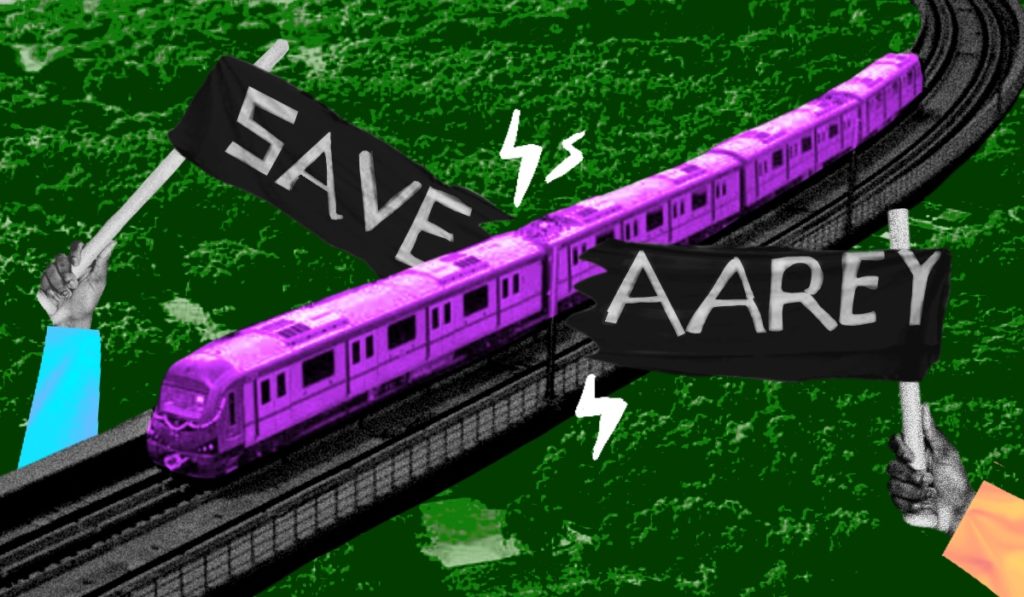[ad_1]
On Friday, the newly-formed Maharashtra government reversed a landmark policy on forest conservation. It has decided to shift the contested metro shed that would involve cutting trees in the Aarey forest, a stretch located in Goregaon. The proposed metro shed threatens the livelihood, homes, and security of almost 8,000 tribal people in the area, in addition to risking the indigenous knowledge and ecological wealth that rests there. Over time, the “Save Aarey” movement has grown in intent and purpose to represent a larger fight against the occupation of India’s precious natural forest resources for industrial and “development” reasons.
The Swaddle’s Saumya Kalia speaks to Neelam Ahluwalia, who actively campaigns for all forest and environment campaigns across India, to understand the role of citizen movements around the climate crisis, and what is lost by undoing #SaveAarey, and the gains made since.
The Swaddle: What was achieved through the Aarey forest protest as a citizen-led movement?
Neelam Ahluwalia: I remember that night in October 2019 when the Maharashtra government axed 300 plus trees in Aarey. So many Mumbaikars from different walks of life reached the site to save the trees. It was so inspiring to see their passion. A few citizens were arrested that night for standing up for their green lungs. Environment groups across India participated in tweetstorms demanding that the charges against these Mumbaikars be dropped. In 2019, the former Chief Minister Uddhav Thackeray-led MVA government in Maharashtra decided to shift the metro depot out of Aarey, following citizen protests against its construction in one of few remaining green areas in Mumbai. Subsequently, the MVA government-designated Aarey colony as a reserve forest. This significant victory in the Save Aarey struggle gave hope to forest campaigners fighting to protect their greens in different parts of India that there is light at the end of the tunnel.
While the fight to Save Hasdeo forest in Central India has been a tribal-led movement that has inspired Indians across the country, the Save Aarey campaign has been an urban movement that has inspired many city folks to stand up for their natural ecosystems. Mumbaikars used the power of social media and Tweetstorms very effectively to amplify the cause of saving their urban forest and the Save Aarey forest campaign got a lot of national and international support. When the Aravalli Bachao campaign was started to save India’s oldest mountain range in February 2019, we learned a lot from the Aarey struggle. Key people of the Aarey campaign guided and supported us. They encouraged the Aravalli Bachao team to start our social media handles to reach out to a wider audience and also file legal cases for the protection of the Aravallis.
TS: What does the reversal mean for forest saving movements and the attitude towards climate action overall? What is lost with the new state government’s decision?
NA: Citizens across India stand in solidarity with the Aarey forest to vehemently object to the ecocidal decision of the new Maharashtra government to build a metro car shed in this pristine ecosystem. This autocratic decision of the new government is completely against the will of the people of Mumbai. This construction activity will open the door for real estate development in Aarey, leading to the destruction of Mumbai’s green lungs, a critical water recharge zone, and wildlife habitat.
Related on The Swaddle:
At a time when the world is witnessing irreversible climate change and 2021-2030 has been declared by the United Nations as the ‘Decade of Ecosystem Restoration’ calling all nations to protect and restore natural habitats, it is very disheartening to see India’s elected leaders taking one ecocidal decision after another and opening our forests for commercial, real estate, mining, and industrial development. What will we do with all the buildings and mines when we lose all our carbon sinks and our lifelines for fresh air and water security? As India destroys its forests in one state after the other in the name of “progress,” the impacts of climate change and nature’s fury will strike us harder creating wars over water, food, and other resources in the next few years. The future of our children is being hugely compromised.
TS: What bearing does the decision have on indigenous knowledge and the people who live in the colony?
NA: There are many tribal communities and wild animals living inside Aarey. This forest is their home. They have lived here sustainably for eons. The building of the metro car shed will result in the cutting of old-growth trees and the destruction of the forest. Reduction in the habitat will lead to an increase in instances of man-animal conflict.
TS: It took an immense fight for Aarey to be acknowledged as a forest rather than grazing land. The same goes for Aravalli Bachao and Save Hasdeo. What is the future of citizen-led protests in leading climate activism? How do people reignite a fight they thought they had won?
NA: Citizens will not give up the good fight to Save Aarey or our other forests across India. With India being one of the most vulnerable nations to the climate crisis, we cannot afford to give up. The fight to save Aarey and our other natural habitats will continue.
But also to put the decision in perspective: Aarey forest is typically a city forest. Whereas Aravallis are spread across four states; Hasdeo too is spread across a much bigger area [Last month, three mining projects in Hasdeo’s Aranya, Chattisgarh, were put on hold indefinitely due to the tireless activism of local citizens]. It’s much much bigger. We still have to do what we have to do. It’s not the end of the road — the fight will go on.
[ad_2]
Source link
